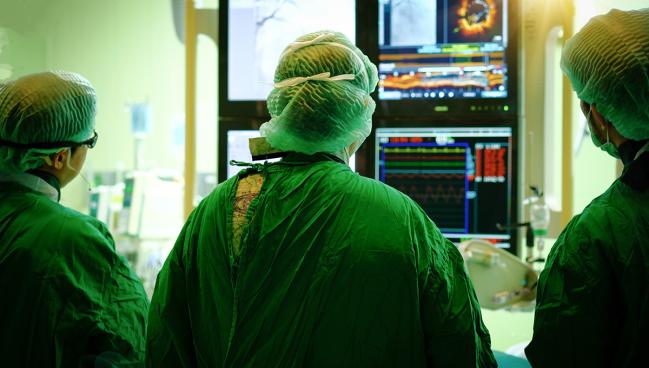Certain Periprocedural MIs Don’t Matter, New Data Allege
Only when the Fourth Universal Definition of MI was adjudicated with two or more clinical criteria was it prognostically relevant.

To be clinically useful, definitions of periprocedural MI should take into account two or more criteria beyond troponin changes, new research suggests. Using troponin plus a single additional clinical metric, as set out in the Fourth Universal Definition of Myocardial Infarction1 (UDMI), just doesn’t cut it for predicting subsequent events, say the study authors.
Among 1,010 patients who underwent elective PCI at a single center, the risk of death at 1 year was only increased in those with periprocedural MIs adjudicated using elevations in cardiac troponin plus two or three clinical criteria, such as ECG changes, imaging abnormalities, or angiographic complications.
“When it comes to the mortality risk at 1 year, periprocedural MI due to one single criterion was not prognostically relevant,” lead investigator Raffaele Piccolo, MD (University of Naples Federico II, Italy), told TCTMD. “In contrast, when you had a periprocedural MI with two or three criteria, the risk of mortality was fivefold higher in comparison to patients without any periprocedural MI.”
There is no shortage of definitions for periprocedural MI and no lack of controversy around their use in randomized trials. Some have even suggested it might be worth abandoning the endpoint altogether given the amount of confusion it causes. In addition to the UDMI, there is the Society for Cardiovascular Angiography and Interventions (SCAI) definition, plus variations used in the SYNTAX, EXCEL, and ISCHEMIA trials. Different studies have challenged the clinical relevance of the various definitions, particularly in research comparing PCI versus CABG or PCI versus medical in stable chronic coronary syndromes.
Much of the confusion about periprocedural MI centers around the variety of definitions used, said Piccolo. “There is a lot of controversy for two reasons. The first is related to the prognostic impact, and the second is related to the incidence of periprocedural MI because when you use, for example, the Fourth Universal Definition, you have a very high rate of periprocedural MI, [often] in the order of 50% of all PCI procedures.”
Two-Thirds of MIs Based on Single Criterion
In this new study, which was published as a research letter in the Journal of the American College of Cardiology, the researchers tested the prognostic significance of the criteria used to adjudicate periprocedural events as part of the Fourth UDMI. In addition to elevations in cardiac troponin levels after PCI, the UDMI requires one or more of the following: electrocardiographic changes reflecting ischemia, cardiac imaging evidence of new loss of viable myocardium/new wall motion abnormalities, or angiographic findings consistent with procedural flow-limiting complications.
Adjudicated periprocedural MI occurred in 174 patients (17.4%), of which 71.3% were captured with a single criterion and 28.7% with two or three criteria. The criteria that led to the periprocedural MI adjudication included ECG changes in 105 patients, angiographic complications in 79 patients, and imaging evidence in 51 patients.
Overall, patients with periprocedural MI had a more than twofold higher risk of mortality at 1 year when compared with those without MI (6.9% vs 2.6%; adjusted HR 2.47; 95% CI 1.19-5.12). However, periprocedural MI adjudicated using only a single criterion was not associated with an increased risk of death (adjusted HR; 1.39;95% CI 0.52-3.75). In contrast, as noted, events adjudicated with two or three criteria were associated with higher mortality at 1 year compared with those without MI (adjusted HR 5.38; 95% CI 2.24-12.9).
Given the results, Piccolo thinks it might be time to redefine and harmonize the definition of periprocedural MI to include more than a lone clinical criterion to capture events. “I think that we probably should take into account a prognostically relevant myocardial infarction during the periprocedural phase with two or three criteria,” he said.
Piccolo stressed that their research is not meant as a knock against the UDMI. In fact, their study supports the definition, he said, noting that they also validated each of the criteria independent of cardiac troponin. The calculations showed that ECG changes, imaging findings, and angiographic complications were all associated with a higher risk of death at 1 year. “So, the criteria are okay,” he said. “The criteria are prognostically relevant and we’re confirming their usefulness in clinical practice.”
The study also has implications for research and practice, said Piccolo, noting that the relative risk-benefit trade-off of PCI versus medical therapy in stable patients remains a controversial topic. In the ISCHEMIA trial, for example, there was no difference in the overall risk of MI in patients randomized to optimal medical therapy versus those randomized to an invasive strategy with PCI or CABG surgery. However, periprocedural MI was significantly higher in the invasive arm while the risk of type 1 MI was lower with revascularization.
“You can’t compare a periprocedural MI without any prognostic impact with a spontaneous MI, which has a very negative prognosis during long-term follow-up,” said Piccolo. “It may explain why the overall effect is neutral on MI in ISCHEMIA and why the long term follow-up, if you see the data, [suggests there is] benefit [with revascularization] on cardiac mortality accumulating over time. This may be due to the prevention of spontaneous MI events.”
Michael O’Riordan is the Managing Editor for TCTMD. He completed his undergraduate degrees at Queen’s University in Kingston, ON, and…
Read Full BioSources
Piccolo R, Angellotti D, Simonetti F, et al. Evidence supporting criteria for periprocedural myocardial infarction in patients undergoing elective percutaneous coronary intervention. J Am Coll Cardiol. 2024;83:1713-1715.
Disclosures
- Piccolo reports personal fees from Abiomed, Amarin, Biotronik, Chiesi, and Medtronic.





Comments